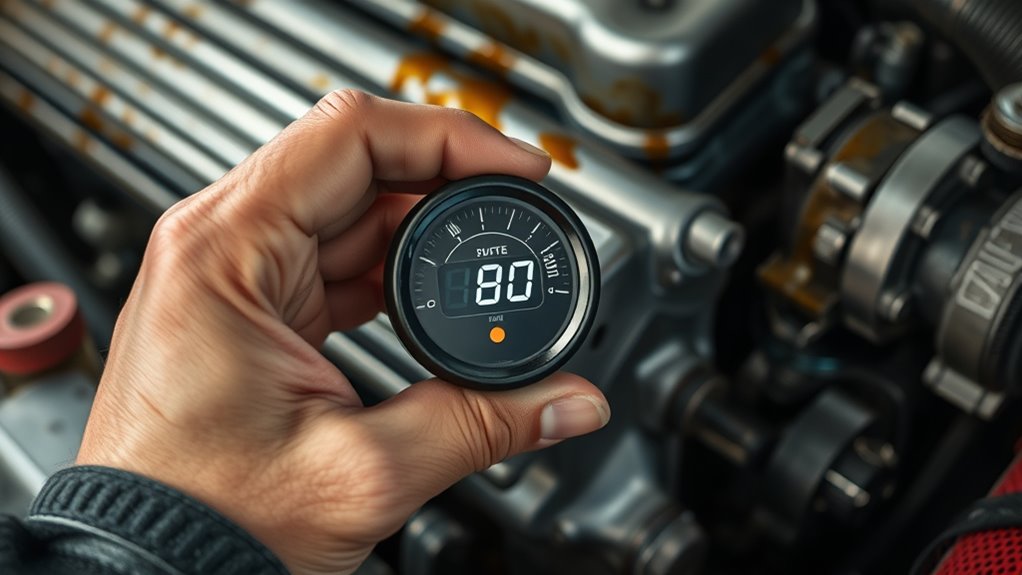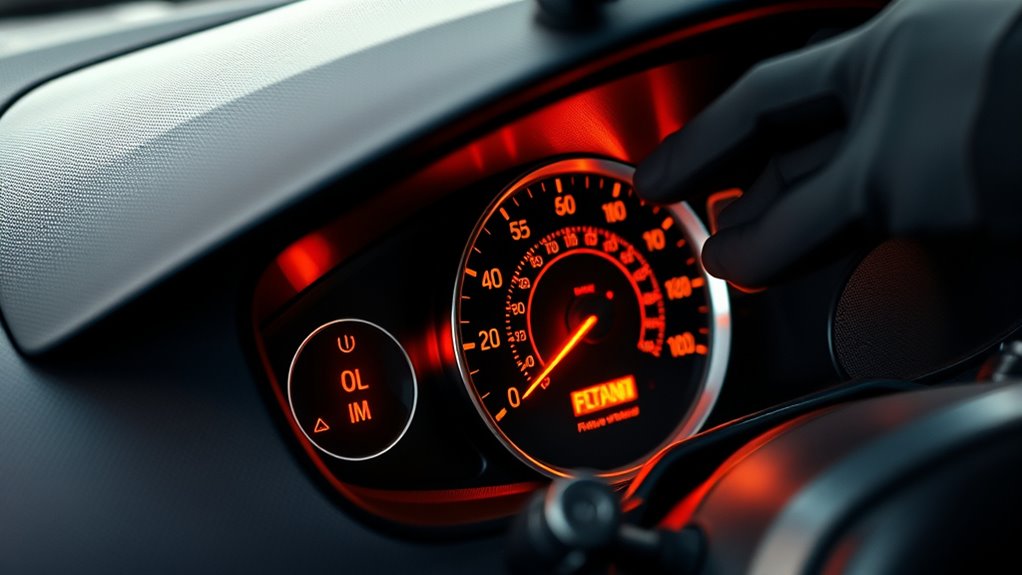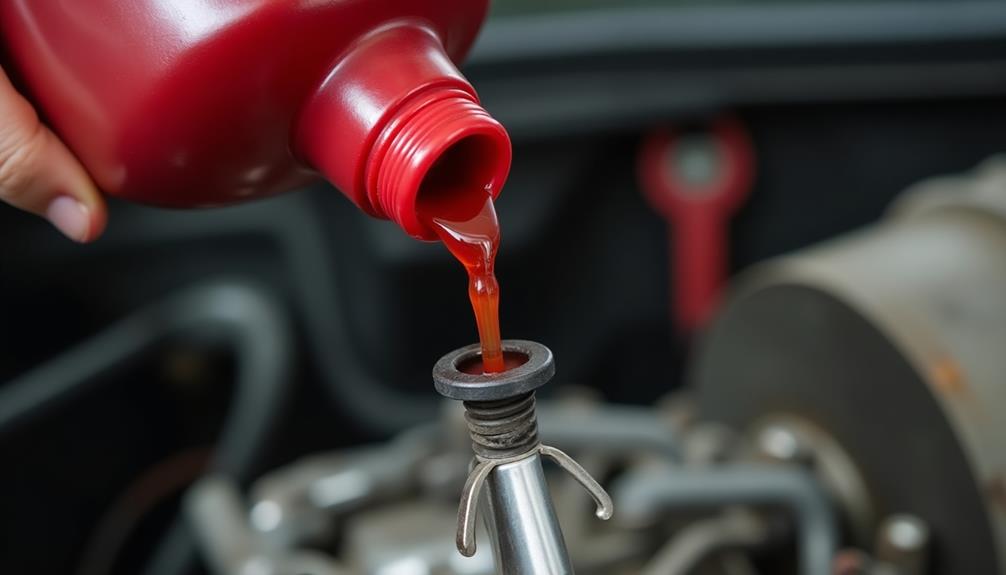If your oil pressure drops, start by checking your oil level and condition, ensuring the oil is clean and at the correct level. Listen for unusual engine noises and watch for dashboard warning lights. Test or replace your oil pressure sensor if needed, and verify that the oil pump is functioning properly. Using the right viscosity oil is vital, and addressing these signs early helps prevent costly engine damage. Keep following for more detailed steps to diagnose and fix low oil pressure effectively.
Key Takeaways
- Check oil level and condition; low or dirty oil can cause pressure issues.
- Inspect the oil pump for proper operation or signs of wear and failure.
- Test or replace the oil pressure sensor to rule out false readings.
- Verify the use of correct oil viscosity as per manufacturer recommendations.
- Review recent oil changes and overall engine health for potential underlying problems.

Low oil pressure can be a serious issue that signals underlying engine problems, so maintaining it promptly is essential. When you notice your dashboard warning light or experience engine noise, it’s a clear sign that something’s off. One of the most common causes is a malfunctioning oil pump, which is responsible for circulating oil throughout your engine. If the oil pump isn’t working properly, it can’t generate the necessary pressure to lubricate engine parts effectively. This can lead to increased wear and potential engine damage. Checking the oil pump’s condition should be part of your diagnosis if low oil pressure persists.
Another key factor influencing oil pressure is oil viscosity. Oil viscosity refers to how thick or thin the oil is at a given temperature. If you use oil that’s too thin for your engine’s specifications, it may flow too easily, resulting in lower-than-normal oil pressure. Conversely, using oil that’s too thick can cause resistance and pressure buildup, but it may also starve parts of lubrication if it doesn’t circulate properly. Always verify you’re using the manufacturer-recommended oil viscosity; this is essential for maintaining proper oil pressure. Changing oil viscosity without considering your engine’s needs can cause fluctuations in pressure, potentially leading to engine damage over time.
To diagnose low oil pressure, start by inspecting the oil level and condition. If the oil is low or dirty, it can impair circulation, causing pressure drops. If the oil level is fine, but pressure remains low, consider whether the oil pump is functioning correctly. A failing oil pump might produce insufficient pressure because of wear, clogging, or mechanical failure. You can also check the oil pressure sensor or sending unit; sometimes, faulty sensors give false readings, so replacing or testing this component can clarify whether the issue lies with the sensor or the actual oil pressure.
Additionally, engine oil quality plays a vital role in maintaining proper pressure, as degraded or contaminated oil can impair circulation and lubrication. Remember that oil viscosity plays a role in pressure as well. If you recently changed your oil type and noticed pressure problems afterward, it might be due to using an incorrect viscosity grade. Always stick to the recommended oil for your vehicle’s engine. If you’re unsure, consult your owner’s manual or a mechanic. Addressing low oil pressure promptly helps prevent severe engine damage, whether it’s caused by a failing oil pump, inappropriate oil viscosity, or other underlying issues. Regular maintenance, including oil changes with the correct viscosity, can go a long way in keeping your engine running smoothly and avoiding costly repairs down the line.
Frequently Asked Questions
How Often Should I Check My Oil Pressure?
You should check your oil pressure regularly, ideally every month or every 1,000 miles. Keep an eye on your oil pressure sensors to make sure they’re functioning correctly, as faulty sensors can give false readings. Regular checks help you spot issues early and verify that your oil pump is working properly. If you notice any fluctuations or warning lights, get your oil pressure checked immediately to prevent engine damage.
Can Low Oil Pressure Cause Engine Failure?
Think of your engine like a heart, and the oil pump as its lifeline. Low oil pressure can indeed cause engine failure if ignored, as it suggests the oil isn’t circulating properly. Poor oil viscosity or a failing oil pump reduces lubrication, leading to increased wear and overheating. This can ultimately cause parts to seize or break, risking costly repairs or complete engine failure. Regular checks help keep your engine healthy.
What Are the Risks of Ignoring Low Oil Pressure?
Ignoring low oil pressure can seriously damage your engine. The oil pump won’t circulate enough oil, leading to increased friction and overheating. An oil sensor might alert you, but neglecting it worsens the problem. Over time, this can cause engine parts to wear out or seize, risking costly repairs or engine failure. Always address low oil pressure promptly to protect your engine’s health and avoid expensive repairs.
How Long Can I Drive With Low Oil Pressure?
You shouldn’t drive long with low oil pressure. Even if you think the oil pump is fine and the oil viscosity is correct, prolonged driving risks engine damage. Low oil pressure means your engine isn’t getting enough lubrication, causing parts to wear faster or seize. Usually, you only have a few minutes to address the issue before serious damage occurs. Stop and check your oil level and condition immediately.
Does Oil Type Affect Oil Pressure Readings?
Yes, oil type affects oil pressure readings. Thicker oils with higher viscosity, like synthetic or heavy-weight oils, can increase pressure, while thinner oils with lower viscosity may lower it. Oil additives can also influence pressure by improving flow or creating a better seal within engine components. Always use the recommended oil viscosity and additives for your engine to maintain proper oil pressure and guarantee ideal performance.
Conclusion
Remember, when it comes to low oil pressure, early diagnosis is key. Don’t ignore warning signs or delay repairs, as neglect can lead to serious engine damage. Regular checks and prompt action save you time, money, and headaches down the road. Keep in mind the old adage: “A stitch in time saves nine.” Stay proactive, and your engine will thank you for it by running smoothly and reliably for miles to come.









